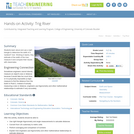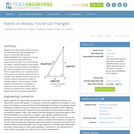
Free online mobile-friendly Trigonometry end-page notes and formulas.
- Subject:
- Mathematics
- Trigonometry
- Material Type:
- Diagram/Illustration
- Lecture
- Lecture Notes
- Date Added:
- 03/16/2014

Free online mobile-friendly Trigonometry end-page notes and formulas.

Students learn about and use a right triangle to determine the width of a "pretend" river. Working in teams, they estimate of the width of the river, measure it and compare their results with classmates.

Book description: This is a text on elementary trigonometry, designed for students who have completed courses in high-school algebra and geometry. Though designed for college students, it could also be used in high schools. The traditional topics are covered, but a more geometrical approach is taken than usual. Also, some numerical methods (e.g. the secant method for solving trigonometric equations) are discussed. A brief tutorial on using Gnuplot to graph trigonometric functions is included.
There are 495 exercises in the book, with answers and hints to selected exercises.

This text covers the content of a standard trigonometry course, beginning with a review of facts from geometry.

Short Description:
This book covers the major topics within the study of trigonometry, including vectors and their applications.
Word Count: 4496
ISBN: 978-1-946135-81-0
(Note: This resource's metadata has been created automatically by reformatting and/or combining the information that the author initially provided as part of a bulk import process.)

The precursors to what we study today as Trigonometry had their origin in ancient Mesopotamia, Greece and India. These cultures used the concepts of angles and lengths as an aid to understanding the movements of the heavenly bodies in the night sky. Ancient trigonometry typically used angles and triangles that were embedded in circles so that many of the calculations used were based on the lengths of chords within a circle. The relationships between the lengths of the chords and other lines drawn within a circle and the measure of the corresponding central angle represent the foundation of trigonometry - the relationship between angles and distances.

This trigonometry textbook is different than other trigonometry books in that it is free to download, and the reader is expected to do more than read the book and is expected to study the material in the book by working out examples rather than just reading about them. So this book is not just about mathematical content but is also about the process of learning and doing mathematics. That is, this book is designed not to be just casually read but rather to be engaged.
Since this can be a difficult task, there are several features of the book designed to assist students in this endeavor. In particular, most sections of the book start with a beginning activity that review prior mathematical work that is necessary for the new section or introduce new concepts and definitions that will be used later in that section. Each section also contains several progress checks that are short exercises or activities designed to help readers determine if they are understanding the material. In addition, the text contains links to several interactive Geogebra applets or worksheets. These applets are usually part of a beginning activity or a progress check and are intended to be used as part of the textbook.
The authors are very interested in constructive criticism of the textbook from the users of the book, especially students, who are using or have used the book. Please send any comments you have to trigtext@gmail.com.

Learning Outcomes:Students will be able to:analyze situations, check for limitations, and examine appropriate methods of solutions using trigonometrypractice manipulating trigonometric functions and in substituting equivalent expressionswork in small groups encouraging classmates and communicating thoughts

CK-12 Foundation's Trigonometry FlexBook is an introduction to trigonometry for the high school student. It includes chapters on graphs of trigonometric functions, trigonometric identities, inverse trigonometric functions, triangles and vectors, and the polar system.

These Trigonometry lecture videos coterminal angles, trig functions, quadrantal angles, special acute angles, co-functions, finding theta, reference angles, trig functions, radian measure, arc length, area of a sector, graphing sine and cosine using t-table, amplitude and frequency, phase shift for sine and consine, vertical shift, tangent curve, cotangent transformations, evaluating trig identities, trig expressions, sum and difference for cosine, double and half angle identities, inverse, principal values, solving difficult trig equations, law of cosines, area of a triangle, and vectors and bearing.

CK-12 Foundation's Trigonometry FlexBook is an introduction to trigonometry for the high school student. Topics include: Trigonometric Identities & Equations, Circular Functions, and Polar Equations & Complex Numbers.

CK-12's Texas Instruments Trigonometry Student Edition Flexbook is a helpful companion to a trigonometry course, providing students with more ways to understand basic trigonometric concepts through supplementary exercises and explanations.

CK-12's Texas Instruments Trigonometry Teacher's Edition Flexbook is a helpful companion to a trigonometry course, providing students with more ways to understand basic trigonometric concepts through supplementary exercises and explanations.

CK-12 Trigonometry Teacher's Edition provides tips and common errors for teaching CK-12 Trigonometry Student Edition. The solution and assessment guides are available upon request.

Short Description:
To understand electrical theory, it is important to have a grasp of trigonometry. Whether we are talking about single phase or polyphase power, trigonometry is a key concept. This textbook, divided into three sections, provides easy-to-understand and enjoyable lessons on trigonometry, vectors and AC generation for those training and working as electricians.
Long Description:
To understand electrical theory, it is important to have a grasp of trigonometry. Whether we are talking about single phase or polyphase power, trigonometry is a key concept. This textbook, divided into three sections, provides easy-to-understand and enjoyable lessons on trigonometry, vectors and AC generation for those training and working as electricians.
Word Count: 6713
(Note: This resource's metadata has been created automatically by reformatting and/or combining the information that the author initially provided as part of a bulk import process.)

Students investigate the relationships between angles and side lengths in right triangles with the help of materials found in the classroom and a mobile device. Using all or part of a meter stick or dowel and text books or other supplies, students build right triangles and measure the angles using a clinometer application on an Android® (phone or tablet) or iOS® device (iPhone® or iPad®). Then they are challenged to create a triangle with a given side length and one angle. The electronic device is used to measure the accuracy of their constructions.

These are the slides needed to teach the Unit Circle lesson. Included are talking points and examples.

This is a PBL project used at the beginning of an Integrated Math course and is intended to help students identify gaps in their foundational knowledge and then fill those gaps by relating the topics to a real-world application in the context of what they want to do for their eventual career. Note that the project was designed and delivered per the North Carolina Math 2 curriculum and also references the North Carolina College Foundation website - both of these items can be customized to meet your own specific curriculum and college/career resources.

Students learn about trigonometry, geometry and measurements while participating in a hands-on interaction with LEGO® MINDSTORMS® NXT technology. First they review fundamental geometrical and trigonometric concepts. Then, they estimate the height of various objects by using simple trigonometry. Students measure the height of the objects using the LEGO robot kit, giving them an opportunity to see how sensors and technology can be used to measure things on a larger scale. Students discover that they can use this method to estimate the height of buildings, trees or other tall objects. Finally, students synthesize their knowledge by applying it to solve similar problems. By activity end, students have a better grasp of trigonometry and its everyday applications.

План заняття з математики